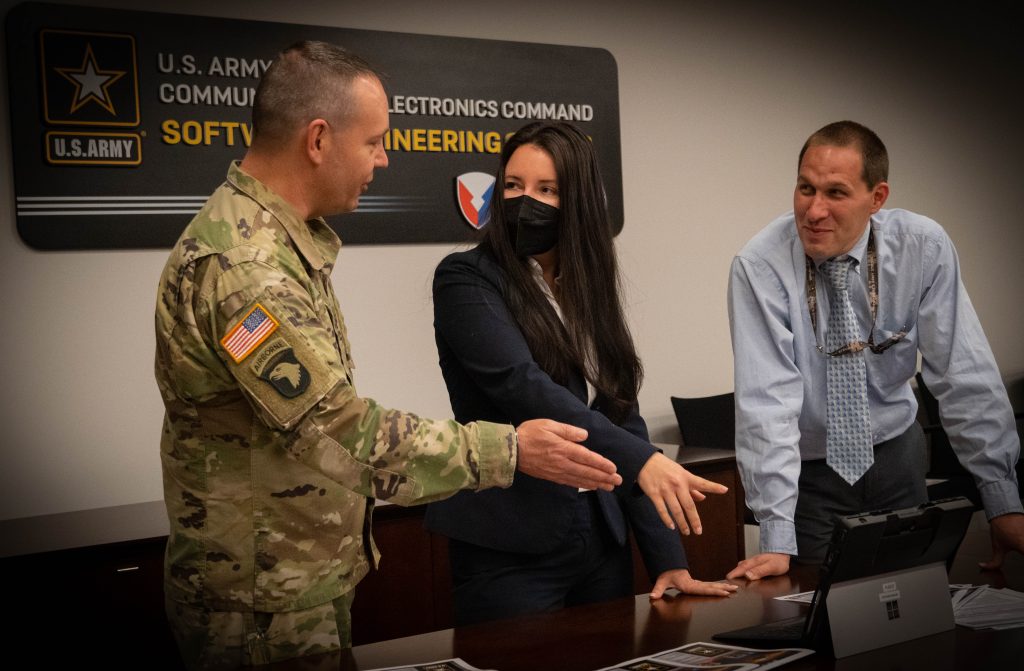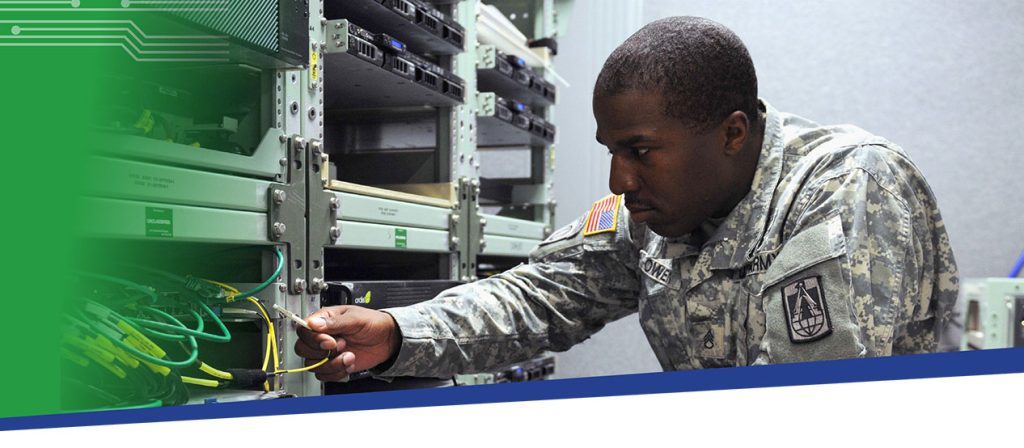
CECOM is shaking up technical data acquisition by seeking neutral ground on government access to intellectual property.
by Troy Saunders
Right now, seemingly more than ever before, the Army sustainment community is facing unprecedented challenges from emerging cyber threats, complex and swiftly evolving technology, and rapid innovation by near-peer adversaries. Fortunately, the Army recognizes that it cannot overcome these challenges with outdated equipment, technology and policies. Over the past few decades, the Army has developed a number of modernization and acquisition reforms to enable the delivery of new warfighting capabilities more rapidly and cost-effectively than in the past.
One of goals of these reforms is to change the Army’s approach to managing intellectual property (IP). IP can include any product of the human mind that is protected by law—including patents, inventions, manufacturing processes, computer software and technical data. It plays a critical role in the military’s ability to modernize weapons systems while maintaining and sustaining technological dominance. Indeed, in December 2019, then-Secretary of the Army, Mark Esper, said, “More than ever, IP is playing a critical role in our ability to modernize our weapon systems and maintain technological overmatch against our peers and near-peers.”
The laws and practices surrounding intellectual property rights are complex, costly and often difficult to manage. As a result, the Army must ensure that the policies and practices governing IP provide the necessary access to effectively support Soldiers and their equipment, while also encouraging innovation from industry partners and the swift delivery of new solutions. Partnership with the industrial base is critical to developing the capabilities needed to be successful during current and future conflicts.

DOWN TO BUSINESS: Danielle Moyer, deputy director of the U.S. Army Communications-Electronics Command (CECOM) Software Engineering Center (SEC), center, and her colleagues discuss new ways the Army can do business and save money in the SEC Headquarters at Aberdeen Proving Ground, Maryland. (Photo by U.S. Army Communications-Electronics Command)
LET’S BE FAIR
It is also crucial that the appropriate safeguards and protections for industry investment are made, keeping long-term sustainment considerations in mind. These safeguards and protections can improve readiness, reduce sustainment costs and increase overall acquisition speed.
Unsurprisingly, the Army has no shortage of hard-charging leaders and innovators who have put in the time and effort to manage costs and streamline the acquisition and sustainment management processes more efficiently. One leader in the world of Army acquisition has been strengthening a reformative concept to help shape a formidable and efficient future Army force.
REFORM BEGINS AT HOME
Danielle Moyer, the dual-hatted deputy director to the U.S. Army Communications-Electronics Command’s (CECOM) Software Engineering Center and director of CECOM Office of Acquisition Support, along with her colleagues at Aberdeen Proving Ground, Maryland, have been using unique and innovative strategies and a reformative concept to elevate the culture of the industry and improve how the Army does business.
“What I’m proposing is that we don’t go back to those old ways where we spent so much time and money on developing things ourselves,” Moyer said. “There’s a middle-ground to still buy commercial off-the-shelf items and nondevelopmental items, to get them fielded fast and tested quickly and, at the same time, consider the total life cycle of the system.” Nondevelopmental items are like commercial products that the Army does not request or pay for the development of but are exclusively sold to the Army and DOD.
That middle-ground Moyer uses is a concept known as technical data escrow—an optimal solution that benefits both the developer and the contracting party to mitigate some risks when negotiating a license for software, technology or relevant IP.
The data escrow account is an account held by a third party, which is then populated by the manufacturer contractor with designated technical data, blueprint, or source code, and will only open and be usable under specified, mutually agreed-upon conditions known as “triggering events.”
Examples of triggering events in the Army acquisition context can range from simple to very complex. This can include a contracting party filing for bankruptcy, or a contracting party that is just unable to provide sustainment support, such as spare part replacements, repairs, software patches, software integration, bug fixes, etc., or simply a manufacturer deciding they no longer want to be in a specific market.

CYBER FOCUSED: A Soldier works on the electromagnetic spectrum. With cyberspace as the newest warfighting domain, on par with air, land, sea and space, the Army is heavily investing on strategies to sustain its multidomain capabilities. (Photo by U.S. Army Communications-Electronics Command)
UNDERSTANDING ESCROW
“An escrow account is like an insurance policy that the Army is the beneficiary to,” said Michael Gomes, chief of the Tactical Radios Branch and contracting officer and an agreements officer for the Army Contracting Command at Aberdeen Proving Ground—and Moyer’s colleague.
Escrow accounts can help to mitigate the risk of discontinued sustainment support, which can potentially save the Army acquisition community frustration, money, and—most importantly—time. Escrow accounts can offer the Army acquisition community a significantly cheaper solution than outright purchase because the government only receives the data deposited into the escrow account. When properly leveraged, escrow accounts provide an additional tool to encourage contractors to continue supporting products, while simultaneously providing the government with a path to ensure continued sustainment in any situation.
Technical data acquisition is often seen as an all-or-nothing game: Either the government buys an expensive technical data package upfront or the contractor holds all the technical data rights, and the government assumes more risk in sustainment. Negotiations for limited IP rights or piecemeal technical data packages often slow down the contracting process and can put a whole program schedule at risk.
The tech data escrow concept provides a more flexible option than just purchasing a technical data package. The arrangement protects government interests and is more affordable than purchasing a technical data package outright, as well as provides increased flexibility for the contractor.
“If [a manufacturer] goes out of business, how will we get their data rights to sustain a system, hardware and software?” Moyer said, describing the current practices. “How will we ensure the Army doesn’t have to start from scratch and that there are not fielded systems inoperable due to lack of long-term planning? Planning for the total life cycle of a system that includes something like data escrow up front is a game changer for the Army.”
The concept provides an affordable way to contract for data that protects government interests while, at the same time, aligning the Army with contemporary and competitive industry practices.

DATA SOLUTIONS: Technical data escrow benefits both the developer and the contracting party, mitigating some risks when negotiating a license for software, technology or relevant IP. (Photo by U.S. Army Communications-Electronics Command)
MAKE IT LIKE BUSINESS
In the world of Army contracting, Moyer has found that insurance for technical data rights is vital for the sustainment process to be successful. As the lead contracting person for both the Product Manager for Airborne Maritime Fixed Station Programs and the Program Executive Office for Command, Control and Communications-Tactical, Moyer along with her colleague Donald Morgan, originally started applying data escrow principles to Army contracts while working on tactical radio contracts in 2013. This led to Moyer and Gomes formally leading the technical data escrow concept across the entire Army Material Command in 2015.
“We all knew that during testing a system can break or something can go wrong; it’s part of the point of testing. Do we just throw that entire system out and buy a whole new one, or is there something in that system’s contract that should fix it at an affordable rate? The same things apply when its fielded, we need to have reach back to fix sustainment systems at an affordable rate and expeditiously,” Moyer said.
Moyer was envisaging these considerations and working towards tangible solutions before coming aboard as CECOM’s contracting lead.
“I thought about all of the things we could do if we thought about them upfront in those PEO contracts. How do we connect all of the different [manufacturers] and manage the contracting process during the total life cycle of a system? What happens when [manufacturers] go out of business? Where are we going to get the parts and directions fast and affordably?”
Moyer asked herself these questions and started to work out the potential benefits of applying industry practices to Army contracts.
“I thought, ‘What about escrow?’” she said. “I found that Amazon and Walmart are involved in a data escrow with their tech data. They ask a third party to hold a vendor’s data and data rights in an escrow account that acts as a kind of insurance policy so that if a vendor fails to perform on part of a contract, the buyer can get the data and data rights and either perform sustainment themselves or re-contract from there.”
CONCLUSION
As Moyer and her CECOM colleagues look to the future of contract reform initiatives, they have been actively reaching out to other organizations for feedback and for opportunities to share their lessons learned.
“I’ve reached out to leaders in the Army outside our command,” she said. “My hope is that other Army and DOD organizations use our lessons learned and apply our total life cycle planning strategies to their systems early.”
Even though the concept of data escrow has been proven successful in the commercial marketplace, the government has yet to widely embrace this innovative approach to acquisition support. As the DOD and Army begin to shape more agile and modern sustainment strategies, adopting the best acquisition practices is key to staying ahead of near-peer adversaries.
The effort Moyer and her team at Aberdeen Proving Ground have put forth has helped streamline the contracting process for a multitude of CECOM programs. And, while acknowledging the challenges the industry faces, she is very hopeful that their work will inspire others to take new approaches towards finding that coveted middle ground between two traditional avenues of technical data acquisition.
“We are trying to get the acquisition community to see how we approach contracting and the benefits of an initiative,” she said. “We want to figure out how to plan for the total life cycle of a system in the smartest way possible for the Army. And how that can be tailored to any individual product.”
With the current geopolitical landscape and an increased focus on cybersecurity, Moyer echoes other leaders in the military acquisition community who call for a more harmonious relationship with the private business sector. Concepts such as data escrow, when properly leveraged, can be a win-win situation for both commercial industry and the Army.
“Army leaders need to have great relationships with industry, because the Army needs industry in order to win on the battlefield,” she said. Building the future force means not only new technology and weapons systems, but new business processes, too, and the work that Moyer and the larger Army acquisition community do every day helps keep our Soldiers safe and equipped to fight.
For more information go to www.cecom.army.mil.
TROY C. SAUNDERS provides contract support to the U.S. Army Communications-Electronics Command as a senior communications specialist. A Marine Corps veteran and Defense Information School graduate, he has years of experience in broadcasting and telling the unique and special stories of service men and women around the world.







